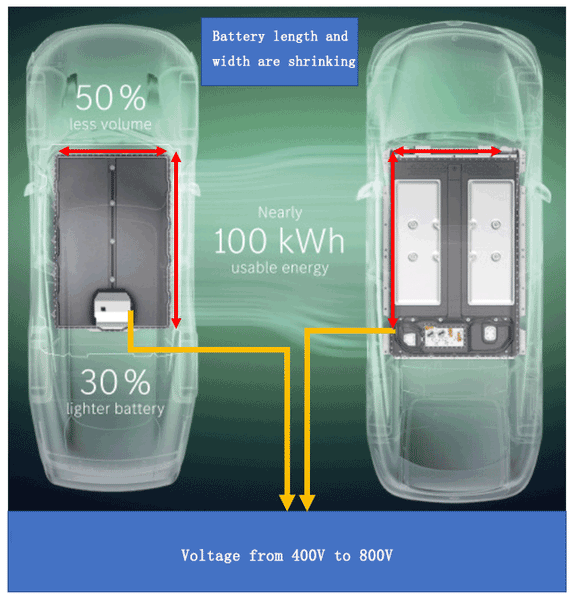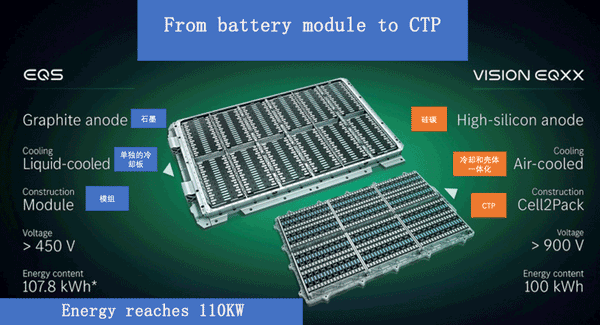Mercedes-Benz has recently started promoting its next-generation electric drive and battery design in Europe, which is also a complete change from 400V to 800V.
According to the time point we have seen before, it will be fully introduced in 2023-2024, and VISION EQXX needs to have great changes in the entire three-electric system, so this time, the battery life test under real road conditions in Europe for the first time has also been vigorously promoted (100kWh The battery has 15% remaining power after driving 1008km on a single charge, and it can run about 140km).
Remarks: Concept cars can sprint for mileage performance regardless of manufacturability
A lot of interesting things can be seen in this battery system:
● Mercedes-Benz will switch from module design to CTP in an all-round way, so how to use the soft-packed batteries of Mercedes-Benz in the future, how long it will take, and the design of 6 large battery blocks that are compatible with the previously seen block design may become an inevitable choice .
● In terms of material system, Mercedes-Benz is divided into existing technology, EQXX technology (graphite is changed to silicon carbon) and solid-state battery, which is described in detail in ESG conference materials later.
● When switching from 400V to 900V, the capacity of the battery becomes smaller, and the width of a single cell also becomes smaller. All European car companies use cells with a thickness of less than 40mm. The reduction in switching capacity this time is mainly achieved by reducing the width.
● Cooling design: here starts from a separate water-cooling plate (thermally isolated from the entire case) to an integration of the water-cooling plate and the case, but the heating method may need to be solved by a high-frequency method, so this change may also revolve around the availability of SiC semiconductors , more suitable for high-frequency switching hooks than IGBTs.
● Of course, in terms of battery design, Mercedes-Benz has given the largest space for the battery cells, and the electrical components are covered like a box.
Focus on the iteration of this battery system.
According to the time point we have seen before, it will be fully introduced in 2023-2024, and VISION EQXX needs to have great changes in the entire three-electric system, so this time, the battery life test under real road conditions in Europe for the first time has also been vigorously promoted (100kWh The battery has 15% remaining power after driving 1008km on a single charge, and it can run about 140km).
Remarks: Concept cars can sprint for mileage performance regardless of manufacturability
A lot of interesting things can be seen in this battery system:
● Mercedes-Benz will switch from module design to CTP in an all-round way, so how to use the soft-packed batteries of Mercedes-Benz in the future, how long it will take, and the design of 6 large battery blocks that are compatible with the previously seen block design may become an inevitable choice .
● In terms of material system, Mercedes-Benz is divided into existing technology, EQXX technology (graphite is changed to silicon carbon) and solid-state battery, which is described in detail in ESG conference materials later.
● When switching from 400V to 900V, the capacity of the battery becomes smaller, and the width of a single cell also becomes smaller. All European car companies use cells with a thickness of less than 40mm. The reduction in switching capacity this time is mainly achieved by reducing the width.
● Cooling design: here starts from a separate water-cooling plate (thermally isolated from the entire case) to an integration of the water-cooling plate and the case, but the heating method may need to be solved by a high-frequency method, so this change may also revolve around the availability of SiC semiconductors , more suitable for high-frequency switching hooks than IGBTs.
● Of course, in terms of battery design, Mercedes-Benz has given the largest space for the battery cells, and the electrical components are covered like a box.
Focus on the iteration of this battery system.

01 Battery system and drive system
The VISION EQXX power battery system has a volumetric energy density of 400Wh/L (200Wh/kg energy density) from the Pack level, and then we can calculate it according to 100kWh, which corresponds to 250L.
If it is disassembled and decomposed by length, width and height, it is estimated to be 2000x1260x110mm, which is similar to this capacity. It is true that the size of this bag has been greatly adjusted. Therefore, the volume is reduced by 50% compared with the previous EQS battery pack, and the weight is also reduced by 30% to 495kg. The working voltage of the battery pack is above 900V.
The VISION EQXX power battery system has a volumetric energy density of 400Wh/L (200Wh/kg energy density) from the Pack level, and then we can calculate it according to 100kWh, which corresponds to 250L.
If it is disassembled and decomposed by length, width and height, it is estimated to be 2000x1260x110mm, which is similar to this capacity. It is true that the size of this bag has been greatly adjusted. Therefore, the volume is reduced by 50% compared with the previous EQS battery pack, and the weight is also reduced by 30% to 495kg. The working voltage of the battery pack is above 900V.

Equivalent to 2 modules of 18 strings placed side by side. Then the beams of the entire tray are canceled here, and then the structural constraints are provided by the side plates and end plates of the 6 battery blocks, and the structural strength is achieved together with the entire tray.
Now in the era of electric vehicles, whether it is cooling or heating, it has become an obvious learning. The thermal management engineer of the whole vehicle needs to coordinate different modes from the whole vehicle to meet the needs of the whole vehicle system with the minimum energy. Here, it is necessary to abandon some of the requirements of the original battery engineer and simplify the battery tray and cooling plate. Of course, the most important thing is that there is an active vent here, which can be adjusted through the switch control to adjust whether the air can enter the battery case. This design is particularly fun.
The electrical system of EQXX is very likely to change the way that there were multiple contactors through iteration. Maybe the engineers of Mercedes-Benz really can't stand the two large modules of 400V and need to deal with the positive and negative poles in parallel. By using circuit breakers, The design of the following EQS can be completely simplified, and the space is suddenly much smaller.
In terms of power system, Mercedes-Benz also uses a very unique cooling method. Of course, I understand that air cooling is a mode. Compared with the high efficiency of water cooling, this mode is more like trying on the basis of the heat resistance of SiC. Moreover, in the non-limit mode, the speed of 60-80 kilometers per hour can be driven by air cooling.
Now in the era of electric vehicles, whether it is cooling or heating, it has become an obvious learning. The thermal management engineer of the whole vehicle needs to coordinate different modes from the whole vehicle to meet the needs of the whole vehicle system with the minimum energy. Here, it is necessary to abandon some of the requirements of the original battery engineer and simplify the battery tray and cooling plate. Of course, the most important thing is that there is an active vent here, which can be adjusted through the switch control to adjust whether the air can enter the battery case. This design is particularly fun.
The electrical system of EQXX is very likely to change the way that there were multiple contactors through iteration. Maybe the engineers of Mercedes-Benz really can't stand the two large modules of 400V and need to deal with the positive and negative poles in parallel. By using circuit breakers, The design of the following EQS can be completely simplified, and the space is suddenly much smaller.
In terms of power system, Mercedes-Benz also uses a very unique cooling method. Of course, I understand that air cooling is a mode. Compared with the high efficiency of water cooling, this mode is more like trying on the basis of the heat resistance of SiC. Moreover, in the non-limit mode, the speed of 60-80 kilometers per hour can be driven by air cooling.

02 Mercedes-Benz's next-generation battery
In ESG, some things are revealed, mainly the research direction of Mercedes-Benz. The current promotion of lithium iron phosphate led by CATL and BYD in Asia will begin to be implemented globally in 2024, so the previous statement that cobalt-free will realize the use of this iron and lithium in the short term.
In ESG, some things are revealed, mainly the research direction of Mercedes-Benz. The current promotion of lithium iron phosphate led by CATL and BYD in Asia will begin to be implemented globally in 2024, so the previous statement that cobalt-free will realize the use of this iron and lithium in the short term.


